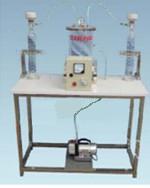Analyze the experimental principle of sludge specific resistance measurement
Note: (This manual and the calculation methods and experimental data provided are for reference only: based on the actual experimental data of the school.) First, the purpose of the experiment: Sludge specific resistance (or specific impedance) is a comprehensive indicator of sludge dewatering performance. The larger the sludge specific resistance, the worse the dewatering performance, and the better the dewatering performance. In this experiment, the specific resistance of activated sludge was determined by using FeCl3 and Al2(SO4)3 as coagulants. I hope to achieve the following objectives through experiments: 1. Master the experimental method for determining the specific resistance of sludge; 2. Master the choice of coagulant using the Buchner funnel test; 3. Master the method of determining the dosage of coagulant. Second, the experimental principle: The sludge specific resistance is the resistance of the unit dry weight filter cake per unit filtration area. When the value is equal to the viscosity, the pressure difference required for the filtrate to produce the unit filtrate flow rate per unit weight of the mud cake is Factors affecting the dewatering performance of sludge include: the nature of the sludge, the concentration of the sludge, the viscosity of the sludge and filtrate, the type of coagulant and the dosage. Usually, the Buchner funnel test is used to determine the specific resistance of the sludge by measuring the speed of the sludge filtrate filtration medium, and the filtration performance of different sludges is compared to determine the optimum coagulant and its dosage. Sludge dewatering relies on the pressure difference between the two sides of the filter medium (porous material) as a driving force to force the water to pass through the filter medium, and the solid particles are trapped on the medium to achieve the purpose of dehydration. There are four ways to create a pressure difference: 1. Static pressure (such as osmotic dehydration of sludge natural drying field) depending on the thickness of the sludge itself; 2. One side of the filter medium causes a negative pressure (such as vacuum filtration and dehydration); 3. Pressurized sludge to filter the moisture (such as dewatering by pressure filtration); 4. Cause centrifugal force as a driving force (such as centrifugal dehydration). According to the evolution of the driving force in the dehydration process, it can be divided into two types: constant pressure filtration and constant vertical filtration. The former remains unchanged in the filtration process; the latter remains unchanged during the filtration process. In this experiment, the pressure difference is caused by vacuuming, and the pressure is adjusted by the regulating valve to make the pressure difference constant throughout the experimental process. At the beginning of the filtration, the filtrate only needs to overcome the resistance of the filter medium. When the filter cake is gradually formed, the filtrate also needs to overcome the resistance of the filter cake itself. The filter cake is made up of particles of sludge and can also be regarded as a porous filter medium. The pores belong to the capillary. Therefore, the true filter layer includes filter cake and filter media. Since the pore size of the filter medium is much larger than the particle size of the sludge particles, only the initial stage of filtration, the filtrate tends to be turbid. As the filter cake is formed, the resistance becomes large and the filtrate becomes clear. Due to the different nature of sludge suspended particles, the properties of filter cake can be divided into two categories: one is incompressible filter cake, such as grit, primary sediment sludge or other inorganic sediment, under pressure, the particles will not be deformed. Therefore, the passage of the filtrate in the filter cake (such as capillary pore size and length) is not changed by the change of pressure; the other type is a compressible filter cake, such as activated sludge, under the action of pressure, the particles will be deformed, with As the pressure increases, the particles are compressed and squeezed into the channels, causing the passage of the filtrate to become smaller and the resistance to increase. Beijing Heng Aode Instrument Co., Ltd. Contact: Wang Rui (Ms.) Bunk Bed,Dormitory Beds,Metal Bunk Beds,Metal Bunker Bed AU-PINY FURNITURE CO., LTD , https://www.jmaupiny.com
